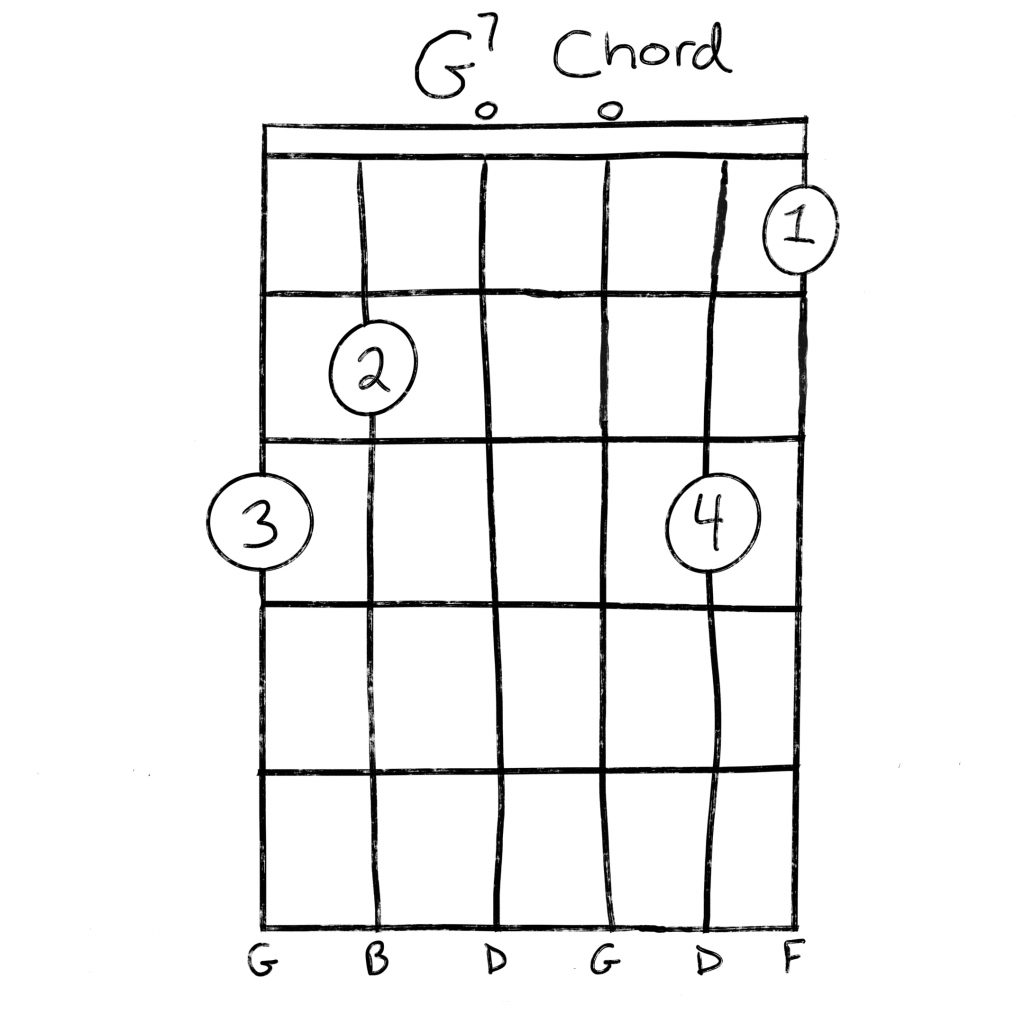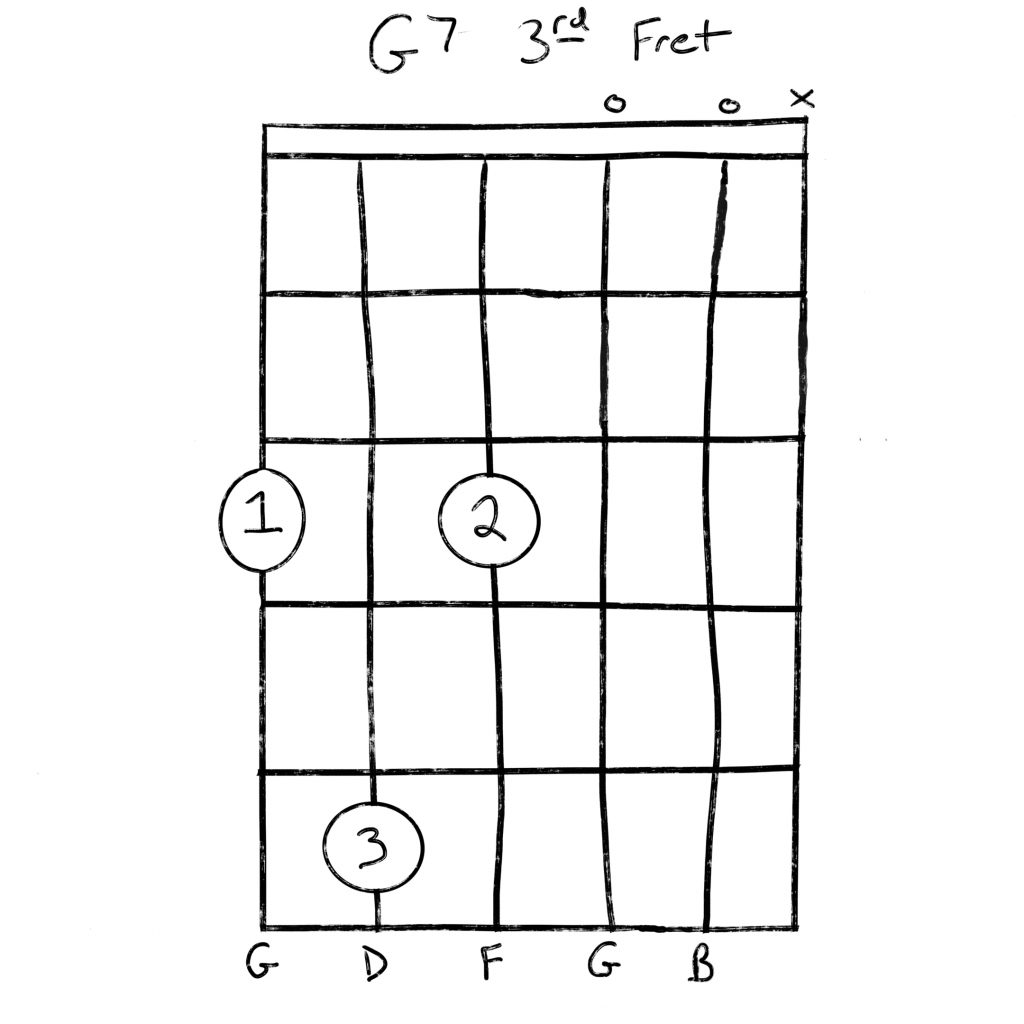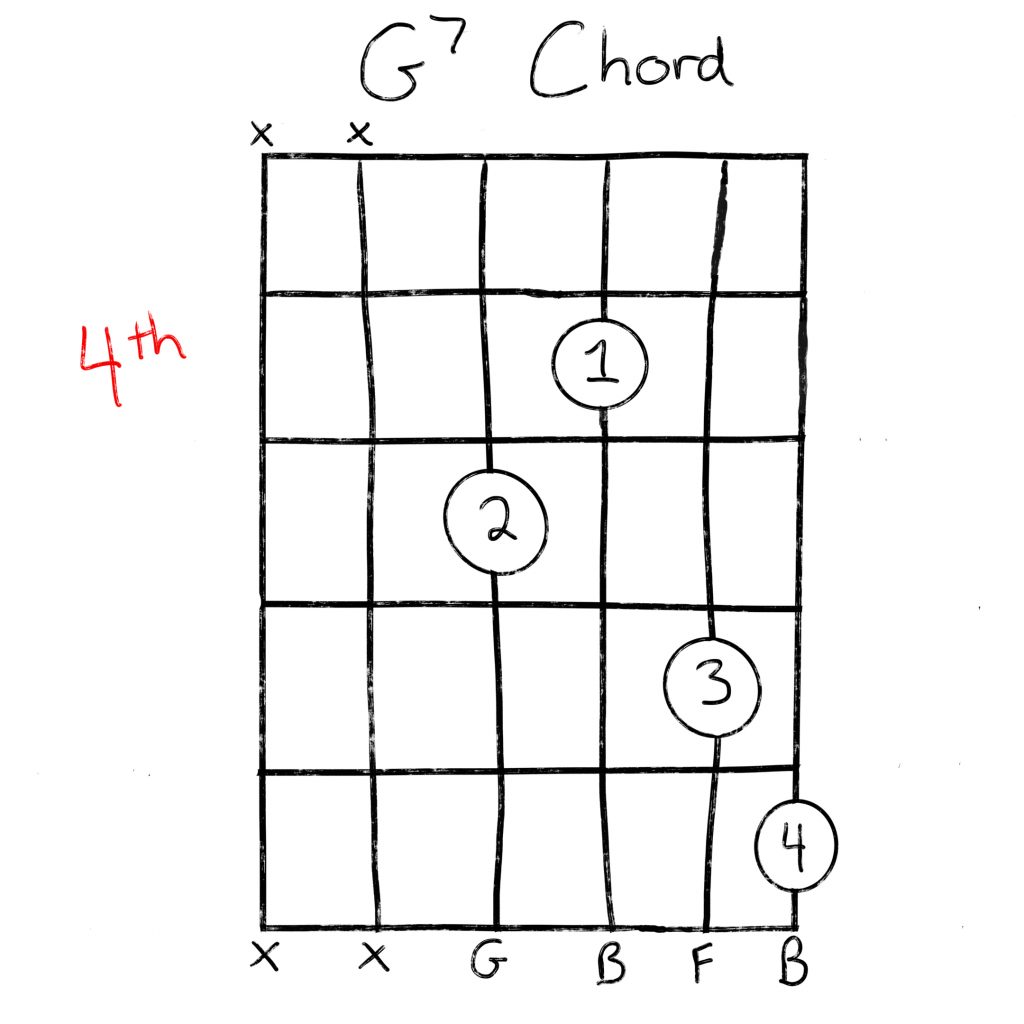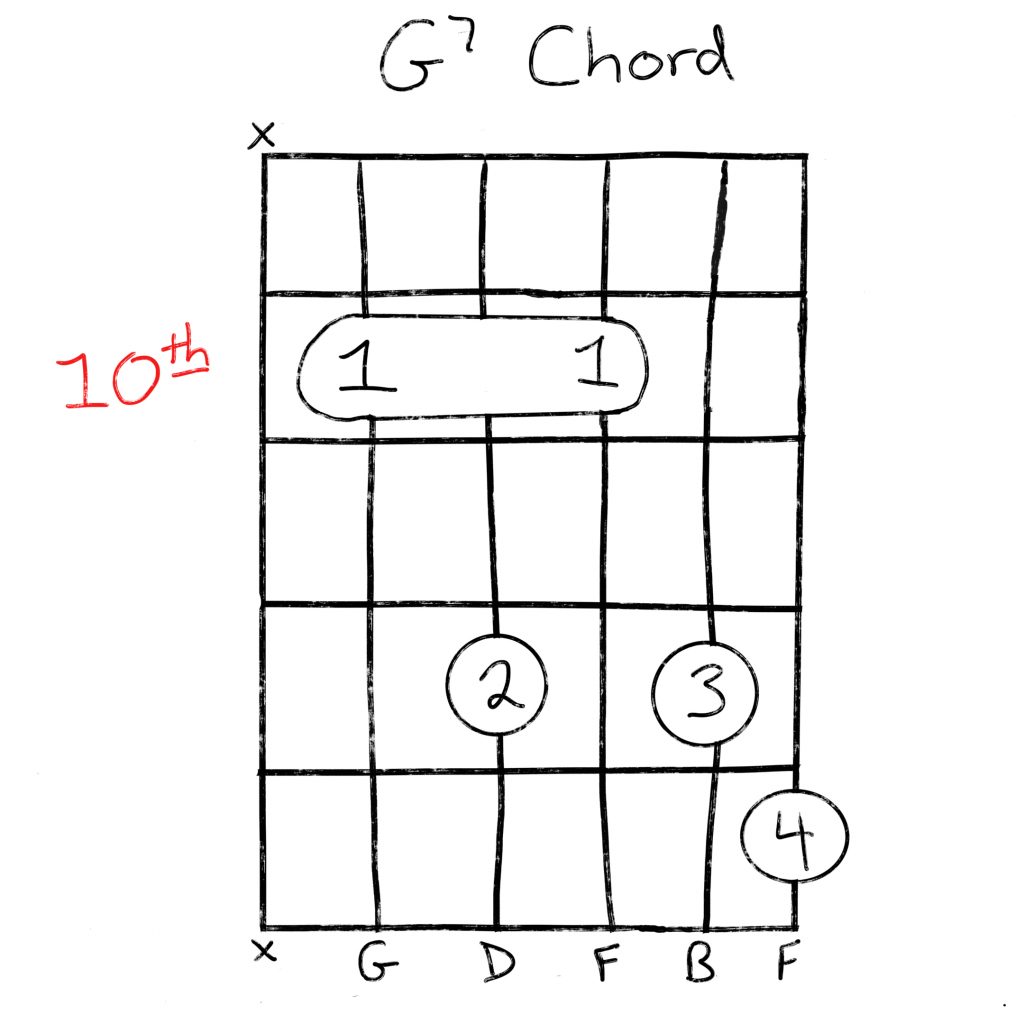The G7 chord for guitar has been used in many a pop, rock, and country song. You can even find it in many traditional Hawaiian ukulele and guitar based songs. The best part is, it's easy to play and is very similar to a standard G chord.
If you have read any of our other 7th chord lessons, you should feel like you are in familiar territory. We have covered A7, B7, D7, and E7, as well as some minor chords too; like Gm7, Bm7, and Dm7.
This lesson will cover how to play the various forms of G7 along the guitar neck. We will also discuss how to build the chord and how to put it into a chord progression. Without further ado, let's get to playing!
How To Play The G7 Chord

This is usually the first way we all learn how to play G7.
- index finger (1) on the F note of the high e string on the 1st fret
- middle finger (2) on the B note of the A string on the 2nd fret
- ring finger (3) on the G note of the low E string on the 3rd fret
- play the D, G, and B strings open

Here is an alternate way of playing a G7 open chord.
- index finger (1) on the F note of the high e string on the 1st fret
- middle finger (2) on the B note of the A string on the 2nd fret
- ring finger (3) on the G note of the low E string on the 3rd fret
- pinky finger (4) on the D note of the B string on the 3rd fret
- play the D and G strings open

If the open chord above is not your first G7, this one probably is.
- index finger (1) barred across all 6 strings on the 3rd fret
- middle finger (2) on the B note of the G string on the 4th fret
- ring finger (3) on the D note of the A string on the 5th fret

This barre chord is the same as the one above with the addition of a high F note
- index finger (1) barred across all 6 strings on the 3rd fret
- middle finger (2) on the B note of the G string on the 4th fret
- ring finger (3) on the D note of the A string on the 5th fret
- pinky finger (4) on the F note of the B string on the 6th fret
More Variations Of The Chord
Let's explore a few more variations of the G7 chord.

This open version is very similar to an open G chord with the ring finger in a different position.
- index finger (1) on the B note of the A string on the 2nd fret
- middle finger (2) on the G note of the low E string on the 3rd fret
- ring finger (3) on the F note on the D string at the 3rd fret
- pinky finger (4) on the G note on the high e string at the 3rd fret
- play the G and B strings open

This is another simple open voicing of G7
- index finger (1) on the G note of the low E string on the 3rd fret
- middle finger (2) on the F note of the D string on the 3rd fret
- ring finger (3) on the D note on the A string on the 5th fret
- play the G and B strings open
- mute the high e string

- index finger (1) on the B note of the G string on the 4th fret
- middle finger (2) on the G note of the D string on the 5th fret
- ring finger (3) on the F note on the B string on the 6th fret
- pinky finger (4) on the B note on the high e string at the 7th fret
- mute the top 2 strings
The Theory Behind It
There's an old stereotype that says theory and guitar players don't go well together. Truth is, that is likely untrue. Learning music theory and understanding how chords are built will not only help you become a better player but it is also pretty interesting as well.
When we build a chord, like a major chord, for example we use a formula called a major triad. When written out, a major triad looks like this: I - III - V, or the 1st, 3rd, and 5th. These are the 1st, 3rd, and 5th notes of the major scale.

The G major scale looks like this:

To build a G7 chord we must first have a G major chord. The notes of G major are:
- G (I)
- B (III)
- D (V)
To make your G chord a 7th chord, all you need to do is add in a bVII, or flat 7th, note.
- G (I)
- B (III)
- D (V)
- F (bVII)
What is the difference between a G7 and a Gmaj7?
A G7 can also be written as Gdom7 or G dominated 7. To make a major chord a 7th chord you add in a bVII, or flat 7th. A Gmaj7, or G major 7, is a major chord with a major 7th.
G7
- G (I)
- B (III)
- D (V)
- F (bVII)
Gmaj7
- G (I)
- B (III)
- D (V)
- F# (VII)
Complementary Chords
Now that we know how to build chords, we can apply that same knowledge to building chord progressions. Almost everything in music theory works on formulas. To figure out what chords we can use in the key of G we use the formula: I - ii - iii - IV - V - vi - vii°.
Note: when a scale degree is lower case (example "iii") that means it is a minor chord. When a note contains the degree symbol (°) that means it is a diminished chord.

The chords available in a G major chord scale are:
- G (I)
- Am (ii)
- Bm (iii)
- C (IV)
- D (V)
- Em (vi)
- F#dim (vii°)
We picked a pretty simple progression for this exercise. It's easy to play but really shows off how interesting 7th chords can make a major chord sound. Try playing I - I7 - IV - IV7 progression, or G - G7 - C - C7, with a slow, bluesy kind of shuffle.
This is how you play that progression:




A Couple More G7 Chord Variations
Here are a few more variations further down the neck, just for good measure

This version uses a D chord shape with the root G played on the D string
- index finger (1) fretting the G note on the G string at the 5th fret
- middle finger (2) fretting the F note on the B string at the 6th fret
- ring finger (3) fretting the D note on the G string at the 7th fret
- pinky finger (4) fretting the B note on the high e string at the 7th fret

- index finger (1) fretting the G note on the B string at the 8th fret
- middle finger (2) fretting the B note on the D string at the 9th fret
- ring finger (3) fretting the G note on the A string at the 10th fret
- pinky finger (4) fretting the F note on the G string at the 10th fret

- index finger (1) barred across the bottom 5 strings on the 10th fret
- middle finger (2) on the D note of the D string on the 12th fret
- ring finger (3) on the B note of the B string on the 12th fret
- mute the top string

This final version is the same as the one above with a high F note added in.
- index finger (1) barred across the bottom 5 strings on the 10th fret
- middle finger (2) on the D note of the D string on the 12th fret
- ring finger (3) on the B note of the B string on the 12th fret
- pinky finger (4) on the F note of the high e string on the 13th fret
- mute the top string
Songs That Have The G7 Chord
The G7 chord can be used in a wide variety of different songs and genres. You can see from the list below we cover rock, pop, country, traditional, gospel, Hawaiian, and more
- Fun Fun Fun by The Beach Boys
- Surfin’ USA by Beach Boys
- Paperback Writer by The Beatles
- Don't Fear the Reaper by Blue Oyster Cult
- I Got You (I Feel Good) by James Brown
- E Huli Makou by David Chung
- The Scientist by Coldplay
- Down On The Corner by Creedence Clearwater Revival
- Island Style by John Cruz
- Shine On by John Cruz
- Baby Love by Diana Ross and The Supremes
- Shining Star by Earth, Wind & Fire
- Lucille by B.B. King
- Ku'u Home O Kahalu'u by Olomana
- Mustang Sally by Wilson Picket
- Hound Dog by Elvis Presley
- What I Got by Sublime
- Amazing Grace by Traditional
- Down In The Valley by Traditional
- Happy Birthday by Traditional
- He's Got the Whole World in His Hands by Traditional
- You Are My Sunshine by Traditional
- La Bamba by Ritchie Valens
- Hey Good Lookin' by Hank Williams
- Jambalaya by Hank Williams
Final Word
After this lesson you, know doubt, love the G7 chord as much as I do. It's a versatile chord and is pretty easy to play up and down the neck. Try making up your own song using this chord and see what you come up with.
Happy practicing!

Leave a Reply